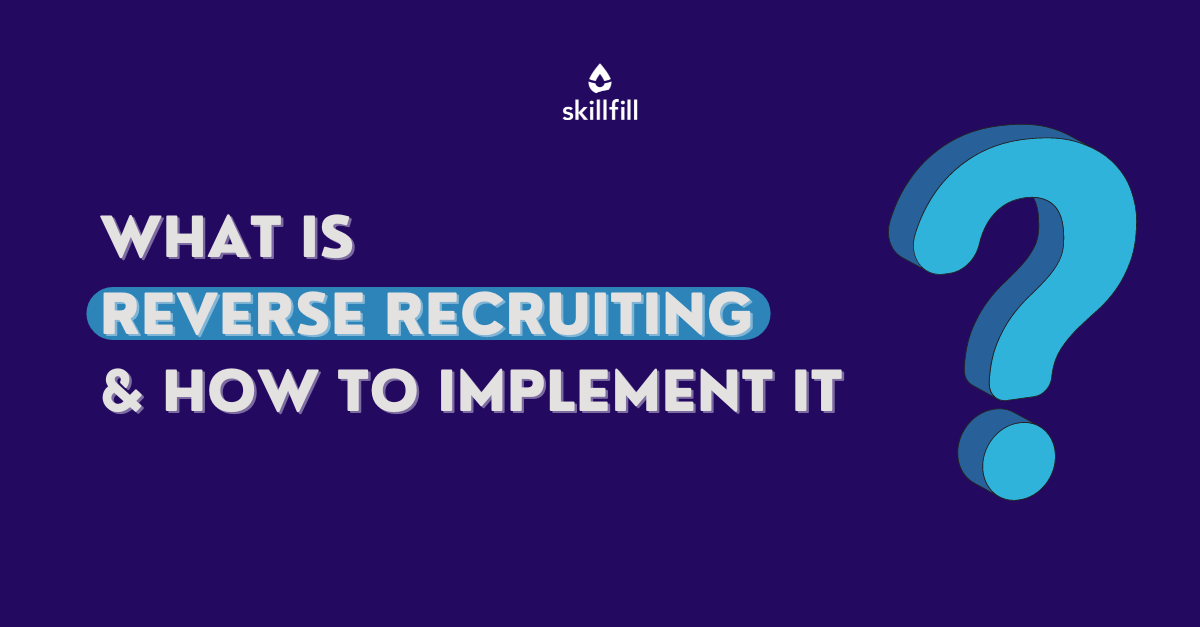Boost Your Hiring Game With Strategic Reverse Recruiting Approaches
In the realm of talent acquisition, typical recruiting methods have actually long been the norm. As the landscape of employing advances, organizations are significantly turning to cutting-edge strategies such as tactical reverse recruiting to obtain an affordable edge in safeguarding top talent. This change in frame of mind needs a thoughtful reconsideration of how companies come close to the employing process, focusing on drawing in passive prospects instead of solely relying upon energetic work candidates. By flipping the script and proactively involving with people who may not be proactively looking for brand-new opportunities, services open themselves as much as a swimming pool of untapped possibility. This tactical technique not only widens the ability pipe yet also grows a more varied and competent labor force.
Understanding Critical Opposite Hiring
Purposefully leveraging the principle of reverse recruiting can substantially enhance your organization's ability acquisition method. By flipping the conventional employment approach on its head, reverse recruiting includes proactively looking for and drawing in easy prospects who might not be proactively searching for brand-new opportunities. This positive method enables firms to take advantage of a swimming pool of premium ability that may not come via typical job posts alone.
Comprehending the details of calculated reverse recruiting is vital for its successful execution. It requires a deep understanding of the industry landscape, rival analysis, and the details ability that are in high demand. reverse recruiting. By carrying out thorough research and leveraging market insights, organizations can recognize and engage with top talent in a much more tailored and targeted fashion

Advantages of Reverse Hiring
Reverse recruiting supplies a distinct strategy to talent purchase by proactively involving with passive candidates that might not be actively seeking task possibilities. This method enables firms to use a swimming pool of talent that standard recruiting approaches might neglect. Among the vital benefits of reverse recruiting is the ability to target candidates that are currently used and satisfied in their current functions. These individuals are usually top performers in their respective fields, bringing useful abilities and experience to the table.

Secret Elements of Reverse Recruiting
Having actually discovered the benefits of reverse recruiting in targeting leading performers who are web content in their present roles, it is important to understand the essential parts that make this approach successful in bring in passive candidates. The very first find key component is developing a solid company brand. Easy prospects are frequently not proactively looking for brand-new opportunities, so having a positive track record as a company can pique their rate of interest. Leveraging social media sites systems and company review websites to display company culture and values can assist hereof.
Another important element is individualized outreach. Because passive candidates are not actively searching for tasks, generic recruitment messages are most likely to be forgotten. Customizing outreach initiatives to highlight exactly how the particular skills and experiences of the candidate straighten with the firm's demands can dramatically boost the possibilities of getting their attention.
Moreover, promoting connections with passive prospects gradually is crucial. On a regular basis engaging with them through networking occasions, market seminars, and even periodic check-ins look at more info can assist build rapport and trust fund, making them extra responsive to prospective job possibilities in the future. By integrating these key parts into reverse recruiting strategies, companies can efficiently attract and work with top ability from the pool of easy prospects.
Implementing Reverse Hiring Strategies

Additionally, producing engaging employer branding and showcasing a favorable firm culture can assist bring in passive candidates and urge them to consider new occupation opportunities. Constructing a talent neighborhood or skill pipe can also be helpful in supporting relationships with passive prospects with time, maintaining them engaged and thinking about prospective future duties within the organization. On the whole, applying reverse recruiting approaches calls for a proactive and tailored method to ability purchase, concentrating on establishing significant links with easy prospects to drive lasting recruitment success.
Determining Success in Reverse Recruiting
Efficient dimension of success in hiring methods calls for a thorough evaluation of key performance indicators and metrics to evaluate the impact and effectiveness of talent acquisition initiatives. In the context of reverse recruiting, details metrics can give beneficial understandings right into the efficiency and effectiveness of the technique. One important metric is the high quality of candidates engaged through reverse recruiting networks. By gauging the conversion price of passive candidates right into active applicants or hires, organizations can determine the performance of their reverse recruiting efforts.
Keeping Continued an eye on retention prices amongst candidates recruited with reverse approaches can offer understandings right into the long-term success of the method. High retention prices recommend that the candidates sourced through reverse recruiting are a great fit for the company, adding positively to its overall skill swimming pool.
Conclusion
To conclude, calculated reverse recruiting provides a special strategy to hiring that concentrates on drawing in top skill via aggressive involvement and relationship-building. By leveraging this method, organizations can acquire a competitive edge in the talent market and improve their recruitment results. It is vital to understand the benefits, key components, and strategies of reverse recruiting to efficiently execute and determine success in this cutting-edge method to working with.
Comments on “From Passive to Proactive: Welcoming Reverse Recruiting in Your Company”